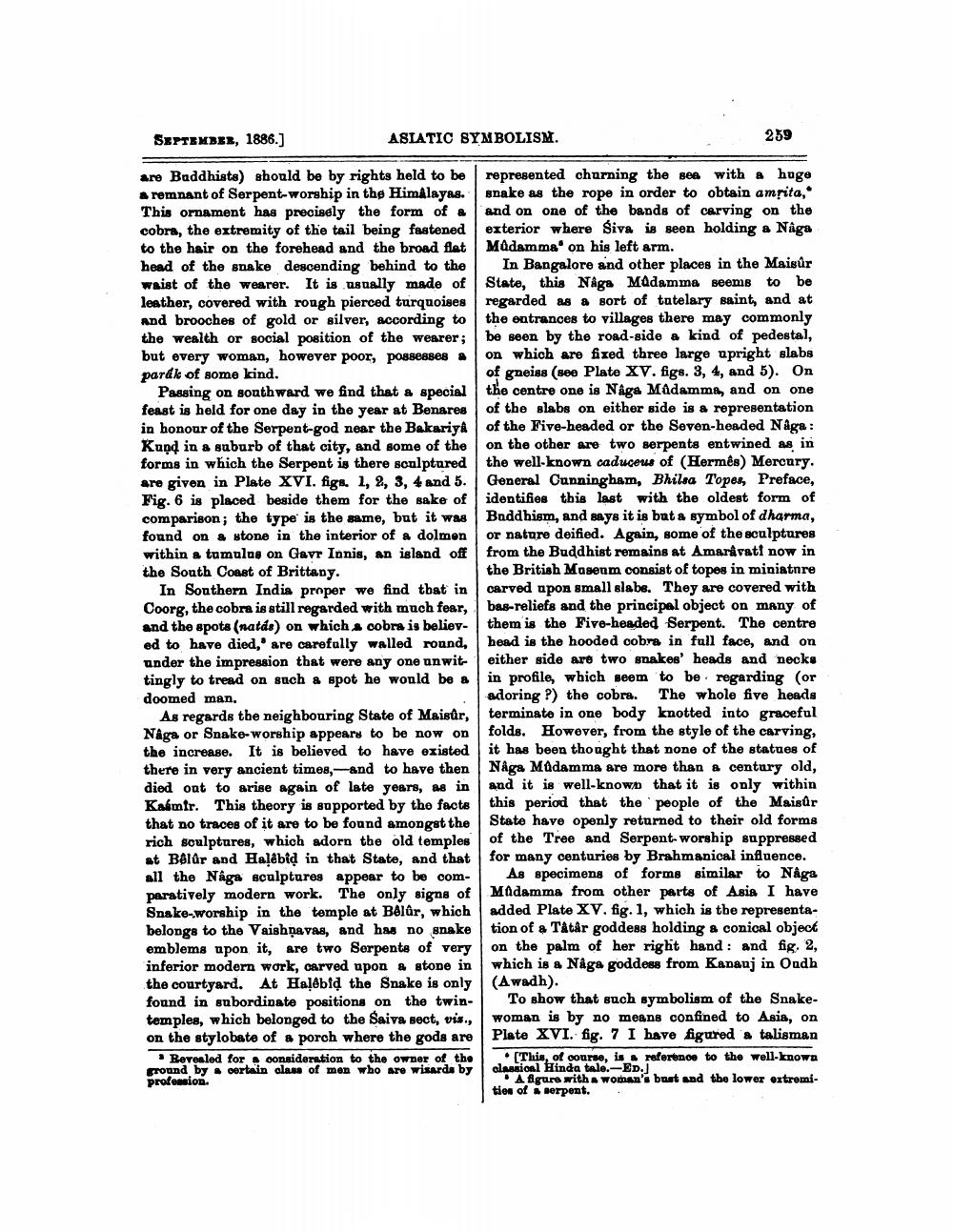________________
SEPTEMBER, 1886.)
ASIATIC SYMBOLISM.
259
are Buddhists) should be by rights held to be represented churning the sea with a huge a remnant of Serpent-worship in the Himalayas. Bake as the rope in order to obtain amrita, This ornament has precisely the form of a and on one of the bands of carving on the cobra, the extremity of the tail being fastened exterior where Siva is seen holding a Naga to the hair on the forehead and the broad flat | Madamma on his left arm. head of the snake descending behind to the In Bangalore and other places in the Maisûr waist of the wearer. It is usually made of State, this Naga Madamma seems to be leather, covered with rough pierced turquoises regarded as a sort of tutelary saint, and at And brooches of gold or silver, according to the entrances to villages there may commonly the wealth or social position of the wearer; be seen by the road-side a kind of pedestal, but every woman, however poor, possesses on which are fixed three large upright slabs paråk of some kind.
of gneiss (see Plate XV. figs. 3, 4, and 5). On Passing on southward we find that & special the centre one is Naga Madamma, and on one feast is held for one day in the year at Benares of the slabs on either side is a representation in honour of the Serpent-god near the Bakariya of the Five-headed or the Seven-headed Naga: Kund in a suburb of that city, and some of the on the other are two serpents entwined as in forms in which the Serpent is there sculptured the well-known caduceus of (Hermês) Mercury. are given in Plate XVI. fig. 1, 2, 3, 4 and 5. General Cunningham, Bhilsa Topos, Preface, Fig. 6 is placed beside them for the sake of identifies this last with the oldest form of comparison; the type is the same, but it was Buddhism, and says it is but a symbol of dharma, found on a stone in the interior of a dolmen or nature deified. Again, some of the sculptures within a tumulos on Gavr Innis, an island off from the Buddhist remains at Amaravati now in the South Coast of Brittany.
the British Museum consist of topes in miniatnre In Southern India proper we find that in carved upon small slabs. They are covered with Coorg, the cobra is still regarded with much fear, bas-reliefs and the principal object on many of and the spots (natda) on which a cobra is believ- them is the Five-headed Serpent. The centre ed to have died, are carefully walled round, head is the hooded cobra in full face, and on under the impression that were any one unwit- either side are two snakes' heads and necke tingly to tread on such a spot he would be s in profile, which seem to be regarding (or doomed man,
adoring ?) the cobra. The whole five heads As regards the neighbouring State of Maisûr, terminate in one body knotted into graceful Naga or Snake-worship appears to be now on folds. However, from the style of the carving, the increase. It is believed to have existed it has been thought that none of the statues of there in very ancient times, and to have then Någa Madamma are more than a century old, died out to arise again of late years, as in and it is well-known that it is only within Kalmtr. This theory is supported by the facts this period that the people of the Maisûr that no traces of it are to be found amongst the State have openly returned to their old forms rich sculptures, which adorn the old temples of the Tree and Serpent-worship suppressed at Bølar and Haļabid in that State, and that for many centuries by Brahmanical influence. all the Nága sculptures appear to be com- As specimens of forms similar to Någa paratively modern work. The only signs of Madamma from other parts of Asia I have Snake-worship in the temple at Balûr, which added Plate XV. fig. 1, which is the representabelongs to the Vaishnavas, and has no snake tion of a Tátår goddess holding a conical object emblems upon it, are two Serpents of very on the palm of her right hand : and fig. 2, inferior modern work, carved upon & stone in which is a Någa goddess from Kananj in Oudh the courtyard. At Halêbid the Snake is only (Awadh). found in subordinate positions on the twin- To show that such symbolism of the Snaketemples, which belonged to the Saiva sect, vis., woman is by no means confined to Asia, on on the stylobate of a porch where the gods are Plate XVI. fig. 7 I have figured a talisman
Revealed for consideration to the owner of the [This, of course, is reference to the well-known round by certain class of men who are wisarda by classical Hinda tale.-ED.] profesion.
A figure with a woman's boat and the lower extremities of Herpent.




